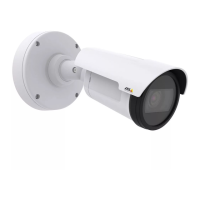
Do you have a question about the Axis P1427–LE and is the answer not in the manual?
| Type | IP security camera |
|---|---|
| PTZ control | - |
| Placement supported | Outdoor |
| Connectivity technology | Wired |
| Wide Dynamic Range (WDR) | Yes |
| Form factor | Bullet |
| Mounting type | Ceiling/wall |
| Product color | White |
| International Protection (IP) code | IP66 |
| Total megapixels | 5 MP |
| Maximum resolution | 2592 x 1944 pixels |
| Supported video modes | 1080p |
| Video formats supported | H.264, M-JPEG |
| Supported graphics resolutions | 320 x 240, 2592 x 1944, 1920 x 1080 (HD 1080) |
| White balance | Auto |
| Angle of rotation | 270 ° |
| Camera shutter type | Mechanical |
| Minimum illumination | 0.07 lx |
| Field of view (FOV) angle | 92 ° |
| Sensor type | CMOS |
| Optical sensor size | 1/3.2 \ |
| Optical zoom | 3.5 x |
| Focal length range | 2.8 - 9.8 mm |
| Password protection type | User |
| Flash memory | 128 MB |
| Compatible memory cards | MicroSD (TransFlash), MicroSDHC, MicroSDXC |
| Maximum memory card size | 64 GB |
| LED type | IR |
| Night vision distance | 15 m |
| Cabling technology | 10/100Base-T(X) |
| Supported network protocols | IPv4/v6, HTTP, HTTPSb , SSL/TLSb , QoS Layer 3 DiffServ, FTP, CIFS/SMB, SMTP, Bonjour, UPnP™, SNMPv1/v2c/v3 (MIB-II), DNS, DynDNS, NTP, RTSP, RTP, TCP, UDP, IGMP, RTCP, ICMP, DHCP, ARP, SOCKS |
| Interface | RJ-45 |
| Ethernet LAN (RJ-45) ports | 1 |
| Power source type | PoE |
| AC input frequency | 50 - 60 Hz |
| Power consumption (typical) | 11.8 W |
| Operating temperature (T-T) | -30 - 50 °C |
| Operating relative humidity (H-H) | 10 - 100 % |
| Minimum RAM | 512 MB |
| Depth | 260 mm |
|---|---|
| Width | 132 mm |
| Height | 90 mm |
| Weight | 871 g |
Defines hazard levels: DANGER, WARNING, CAUTION, NOTICE.
Defines message levels: Important, Note.
Details about physical connectors and buttons on the product.
Information about the SD card slot and recommendations.
Details on the function and usage of the control button.
Explanation of the status LED indicators and their meanings.
Steps to access the product using a web browser.
Instructions for accessing the product remotely over the internet.
Guide to setting the initial root password for security.
Setting camera resolution and frame rate.
Configuring the power line frequency for optimal video.
Overview of the Live View page interface and controls.
Details on H.264 streaming protocols and configurations.
Explanation of MJPEG streaming format and usage.
Guide to using AXIS Media Control for video streaming.
Other ways to access video streams besides AMC.
Essential initial setup steps for the product.
Configuring the product's video streams and settings.
Advanced camera settings for image appearance and control.
Configuring exposure zones and automatic exposure control.
Managing IR cut filter and day/night shift levels.
Defining specific view areas for custom streams and PTZ.
Setting and adjusting focus and zoom for the camera.
Configuring detection of camera tampering and alarm generation.
Information on installing and managing application licenses.
Steps to upload and start applications on the product.
Configuring AXIS Video Motion Detection for motion detection.
Defining conditions and actions for event triggers.
Overview of available triggers for action rules.
List of available actions that can be performed by event rules.
Configuring recipients for event notifications and media.
Configuring email recipients for event notifications.
How to search and locate recorded video files.
Steps to play back recorded video clips.
Procedure for exporting recorded video as a clip.
Configuring the product for continuous video recording.
Instructions for installing and switching languages on the product.
User access control, password settings, and IP address filtering.
Enabling and configuring HTTPS for secure browsing.
Setting up IEEE 802.1X for network authentication.
Managing server/client and CA certificates for authentication.
Configuring the product's date, time, and time synchronization.
Basic TCP/IP settings for IPv4 and IPv6 configuration.
Verifying the current firmware version for troubleshooting.
Procedure for updating the product's firmware.
Steps to recover the product after a failed firmware upgrade.
Troubleshooting common issues and their solutions.
Detailed specifications for the camera sensor, lens, and day/night features.
Specifications for video compression, resolution, frame rate, and streaming.
General specifications including casing, memory, power, and connectors.
Specifications for SD card and network-attached storage support.
List of regulatory and safety approvals for the product.
Detailed specifications for the I/O connector and its pins.
Factors affecting product performance like frame rate and bandwidth.